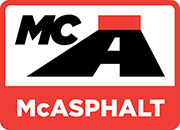Gravel Roads
Dust control is the application of diluted asphalt emulsions, oil-based liquids, chloride salts or organic resins sprayed directly onto or mixed into granular roadbeds. Typically, these materials are applied by a vehicle-mounted distribution system. The application rates vary depending on the product of choice and the material it’s being applied to.
Design Criteria
Examining the granular surface for pre-existing conditions, evaluate the aggregate to be used, understand traffic types and volumes, evaluate local environmental conditions, determine wants, needs and budget. Once the needs assessment is completed an appropriate design can be completed. Designs range from a simple top spray to a complete mix design depending on the assessment.
Materials
Asphalt Emulsions:
Asphalt emulsions are an economical solution and can be formulated with a number of additives for enhancing end use properties. Asphalt emulsions can be top sprayed or road mixed into the top few centimeters.
Organic Polymers:
Organic polymers or lignin’s derived from plants can be used as a natural dust suppressant measure. It very effectively binds the granular surface together. They tend to be viscous products that are typically diluted with water for application.
Chlorides:
Chlorides have a wide range of applications in construction, de-icing and dust control. Used for many years in the industry chlorides still tend to be an industry work horse when it comes to controlling dust. Typical chlorides used include calcium, magnesium and potassium.
Oil Based Liquids:
Oil based materials come in many forms from clear oils to high viscosity cutbacks. Clear oils have been used when the road requires a wet appearance. The high viscosity cutbacks have excellent binding capabilities and work well blade or pulverize mixed into the top few inches of granular material.
Performance Guidelines
In order to construct a proper well designed dust suppressant the following guidelines should be followed:
- Evaluate the material or commodity, determine wants and needs
- Based on the assessment choose the appropriate palliative
- Confirm engineering parameters utilizing a certified laboratory
- Develop storage and handling procedures
- Develop application, QC and QA procedures
